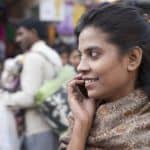How India’s Digital Payments Revolution Can Advance its Position as a ‘Soft-Power Superpower’
The World Bank recently released its latest Global Financial Inclusion Index, highlighting several unprecedented milestones that India has reached.
The number of Indian adults owning a formal account has gone up from 35 percent to 80 percent in just six years. But what’s really remarkable about the news is that women, who globally are twice as likely as men to be financially excluded, have seen their rates of account ownership go up from 27 percent to 77 percent since 2011. In total, nearly 500 million Indians have been financially included.
From Sweden to Indonesia, governments are rapidly shifting from cash to digital payments to increase transparency, reduce costs, create new economic opportunities for small businesses – particularly for women entrepreneurs – and expand access to financial services. Many governments are realizing the potential of moving away from cash. Yet only a handful have embarked on this shift at a scale as large and at a rate as fast as India.
Sharing India’s Financial Inclusion Successes
India’s success in promoting digital payments is remarkable. With government leadership, over 1 billion citizens now have a biometric ID and over 300 million households have gained access to an account under the Pradhan Mantri Jan-Dhan Yojana scheme. Coupled with India’s 1 billion mobile phones, the infrastructure has been built for innovators to develop practical applications like the India Stack, or for companies to suggest financial products that serve those who had been previously excluded from the financial sector. The results are staggering, in terms of efficiency, cost-effectiveness and eliminating “leakages” of funds from the government to citizens. For instance, thanks to the digitization of the Direct Benefit Transfer scheme, the government has already saved US $13 billion, including $6 billion with its cooking gas programme. More citizens are sure to get the subsidies or benefits they deserve with less friction. Hundreds of millions of Indians are now insured for the first time in their lives, and small businesses are increasing their potential thanks to new loans and credit schemes.
Last year, as a member of the United Nations-based Better Than Cash Alliance, India hosted high-level officials of 12 governments, from Mexico to Kenya, to share its achievements to date. Participants returned to their capitals inspired and motivated to apply lessons learnt in their respective administrations. Of particular interest to these countries is India’s biometric unique ID system Aadhaar, and how it is being leveraged for digitizing payments. Smaller countries that have struggled with developing similar systems have been inspired by India’s capacity to register over a billion people in just a few years: They realize that if India, with its 1.3 billion population can do it, they can too.
‘Soft-Power Superpower’
Yet many more countries want to learn from these successes. India is very well positioned to respond to their requests, showcasing its leadership in digital payments globally, and helping other countries that want to reap the benefits of an inclusive digital economy.
India is already a soft-power powerhouse. Bollywood reaches every corner of the globe, Indian cuisine is considered among the best in the world, and yoga is practiced by people everywhere, from Canadian Prime Minister Justin Trudeau to Beyoncé. However, in taking the global lead on digital payments, India can further its position as a soft-power superpower.
Many governments realize that by shifting to digital payments, they can build the rails that will help them reach the 17 ambitious Sustainable Development Goals (SDGs), for both their citizens and businesses. For example, 470 million new jobs are needed by 2030 to meet SDG 8 on Decent Work. Widespread adoption and use of digital financial services could fuel low-cost business models with the potential to boost the GDP of emerging economies by 6 percent, adding $3.7 trillion to their GDP – and creating up to 95 million new jobs by 2025. And SDG 5 on Gender Equality seeks to bridge the gaps in economic opportunities between men and women. Shifting to digital financial services can help empower women to earn more and build assets, providing greater financial power that fuels gender equality and economic growth.
But India can also learn from other countries that are making their own strides in achieving the SDGs by digitizing payments. In Kenya, for instance, millions are now getting access to renewable electricity thanks to pay-as-you-go solar schemes. In Colombia, the government digitally distributes subsidies to millions of women to help them provide their children with health care and enable them to stay in school. And in China, social network platforms have unlocked billions of dollars in financing for small businesses.
As India moves rapidly to build an inclusive digital economy, it can learn from these and other innovative approaches to expand its reach and impact. And as its digital economy grows, India has the potential to inspire other countries as they trace their own path toward inclusive growth.
Tidhar Wald is the head of government relations and public policy, Better Than Cash Alliance, United Nations.
Photo credit: ©Better Than Cash Alliance / Urmila Jagannathan
- Categories
- Finance



